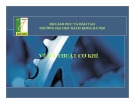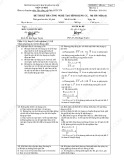
REGULAR ARTICLE
Reassessment of gadolinium odd isotopes neutron cross
sections: scientific motivations and sensitivity-uncertainty
analysis on LWR fuel assembly criticality calculations
Federico Rocchi
1,*
, Antonio Guglielmelli
1
, Donato Maurizio Castelluccio
1
, and Cristian Massimi
2,3
1
ENEA, Italian National Agency for New Technologies, Energy and Sustainable Economic Development,
Centro Ricerche “E. Clementel”, Via Martiri di Monte Sole, 4, 40129 Bologna, Italy
2
Department of Physics and Astronomy, University of Bologna, Via Irnerio, 46, 40126 Bologna, Italy
3
INFN, Via Irnerio, 46, 40126 Bologna, Italy
Received: 8 November 2016 / Received in final form: 11 May 2017 / Accepted: 2 June 2017
Abstract. Gadolinium odd isotopes cross sections are crucial in assessing the neutronic performance and safety
features of a light water reactor (LWR) core. Accurate evaluations of the neutron capture behavior of gadolinium
burnable poisons are necessary for a precise estimation of the economic gain due to the extension of fuel life, the
residual reactivity penalty at the end of life, and the reactivity peak for partially spent fuel for the criticality
safety analysis of Spent Fuel Pools. Nevertheless, present gadolinium odd isotopes neutron cross sections are
somehow dated and poorly investigated in the high sensitivity thermal energy region and are available with an
uncertainty which is too high in comparison to the present day typical industrial standards and needs. This article
shows how the most recent gadolinium cross sections evaluations appear inadequate to provide accurate
criticality calculations for a system with gadolinium fuel pins. In this article, a sensitivity and uncertainty
analysis (S/U) has been performed to investigate the effect of gadolinium odd isotopes nuclear cross sections data
on the multiplication factor of some LWR fuel assemblies. The results have shown the importance of gadolinium
odd isotopes in the criticality evaluation, and they confirmed the need of a re-evaluation of the neutron capture
cross sections by means of new experimental measurements to be carried out at the n_TOF facility at CERN.
1 Introduction
Fuel assemblies (FAs) of light water reactors (LWRs)
(such as PWRs, BWRs, or VVERs) of 2nd and 3rd
generations make extensive recourse to s.c. “burnable
neutron poisons”in various forms and technical solutions.
These burnable poisons are chosen among those isotopes
having thermal neutron capture cross sections comparable
or higher than the thermal neutron fission cross section of
235
U; they are in fact used as competitors to
235
U in the
absorption of thermal neutrons, in such a way that, being
their absorption parasitic for the neutron chain reaction,
they can compensate an initial higher fuel enrichment that,
for safety reasons, could not be inserted in the fuel pins. As
soon as the fuel in the FAs is burnt during the operation of
a given reactor, both
235
U and burnable poisons are
depleted so that the compensating effect of the poisons is
neutralized at a point in the cycle of the fuel at which the
remaining amount of fissile material can be controlled
easily and safely by other available means. This idea can
naturally increase the overall length of the fuel cycle by
allowing higher amounts of fissile material, which corre-
spond to higher enrichments in
235
U, loaded in FAs and
then in reactor cores. This, of course, means in turn better
economy of both the nuclear fuel and of the management of
reactors: fuel reloading into cores can be done after longer
periods of uninterrupted operation [1].
Several types and forms of burnable poisons have been
successfully tested over the past decades; the most common
one being gadolinia (Gd
2
O
3
) mixed directly within the UO
2
fuel matrix; this insures that the burnable poison is never
separated from the active material it must control and also
enhances mechanical properties of the fuel. Gadolinium
oxide is, therefore, a kind of dopant within the UO
2
material itself. The absorption of thermal neutrons is of
course provided by the odd isotopes
157
Gd and, to a far
lesser extent,
155
Gd. Gadolinium is used, for the sake of
simplicity, in its natural isotopic composition. Its first use
in a commercial reactor dates back to 1973.
To give an example, gadolinia as burnable poison is
used presently, and since 2002, in the s.c. Cyclades and
Gemmes core managements schemes by Electricité de
France in its CP0 and 1300 MWe PWR reactors,
respectively [2,3]. Not all FAs in a core contain fuel pins
e-mail: federico.rocchi@enea.it
EPJ Nuclear Sci. Technol. 3, 21 (2017)
©F. Rocchi et al., published by EDP Sciences, 2017
DOI: 10.1051/epjn/2017015
Nuclear
Sciences
& Technologies
Available online at:
http://www.epj-n.org
This is an Open Access article distributed under the terms of the Creative Commons Attribution License (http://creativecommons.org/licenses/by/4.0),
which permits unrestricted use, distribution, and reproduction in any medium, provided the original work is properly cited.

doped with gadolinium; the Gemmes scheme, for instance,
foresees a reload of 64 FAs (corresponding to 1/3 of the
whole core), 24 of which contain some pins with Gd
2
O
3
mixed to UO
2
[2]. The choice of the position within a core
where FAs with gadolinium fuel pins are placed is also
dictated by an optimization of the power density
distribution; such an optimization also favors the achieve-
ment of higher thermal safety margins for these reactors.
Gadolinium isotopes cross sections are therefore
crucial in assessing the neutronic performances and safety
features of FAs and whole cores. The proper knowledge of
these cross sections is not only relevant at the beginning of
life of a FA, but also during its life cycle; in fact, accurate
predictions of the burning rate of odd isotopes are
fundamental in the prediction of the appearance of the
FA reactivity peak and its intensity. In turn, these two
parameters are of utmost importance in the assessment of
the criticality safety margins for the storage of partially
burnt fuel inside Spent Fuel Pools (SFPs) of reactors,
especially during postulated loss-of-coolant or loss-of-
cooling accidents at these storage facilities [4]. The correct
prediction of the 3D spatial distribution of the gadolinium
isotopes remaining within a partially burnt FA that has
been put in interim storage in an SFP, possibly during a
refueling outage of the reactor, is fundamental for a
correct estimate of the criticality safety margins of SFPs.
It must be remembered in fact that the neutron flux
distribution inside a core is far from uniform, with both
axial and radial gradients, which produce a non-uniform
burning of both fissile isotopes and gadolinium isotopes.
A good prediction of the depletion of gadolinium
isotopes is also necessary to estimate the s.c. “residual
reactivity penalty”that is essentially the value of anti-
reactivity associated to the high-burnup, equilibrium
concentrations of odd and even isotopes; this value is
important because if it is too high, it can induce a limi-
tation on the total amount of time a given FA can be used
at full power. This effect is unavoidable but should be well
predictable to foresee a good fuel management scheme. To
give just a rough example, the reactivity penalty due to 16
gadolinium fuel pins with initial 8.0 wt.% of gadolinia in
UO
2
for a 1717 PWR FA (average
235
U enrichment of
4.5 wt.%) corresponds roughly to the “loss”of 5 full-power
days per year [5]. In the electricity energy market of France,
5 full-power days of an III-Generation EPR reactor tally
roughly to 8 M€[6].
A more accurate assessment of gadolinium isotopes
cross sections is also essential for CANDU reactors. In fact,
in the case of severe accidents due to or leading to criticality
excursions, gadolinium nitrate is injected into the heavy
water moderator, to reduce/eliminate criticality risk or
excursions. Finally, it should be remembered that
gadolinium isotopes are also fission products and are
produced by the nuclear fuel as its burnup increases; they,
therefore, act as neutron poisons also in their role of fission
products and they must be accounted for in burnup and
depletion calculations of FAs.
2 Scientific motivation
The necessity of an updating in the gadolinium odd
isotopes cross sections evaluations is based on a series of
quantitative scientific considerations. First of all, as it is
shown in Figure 1, the current gadolinium odd isotopes
(n,g) cross sections (in the ENDF/B-VII.1 library) present,
Fig. 1. Relative standard deviation of
155
Gd and
157
Gd capture cross sections.
2 F. Rocchi et al.: EPJ Nuclear Sci. Technol. 3, 21 (2017)

in the high sensitivity thermal energy range and to the best
of the present knowledge, based on the existing experi-
ments, non-negligible (5–10%) uncertainty values. Fur-
thermore, the capture cross section of the odd gadolinium
isotopes has not been extensively studied and is not known
with the accuracy typically required by the nuclear
industry. Looking at the EXFOR database, there seems
to be available only one experimental point for
157
Gd(n,g)
in the energy region below the resolved resonances, namely
at 2200 m/s, which was determined to be roughly 264 000 b.
This single data-point was published in 1958 and no
uncertainty was associated to it [7]. Again in 1958, the
BNL-325 Report instead gave a value of 240 000 b [8]. In
1960, a second set of data was extracted from total cross
section measurements [9], which gave a value of 254 000 b.
One has then to wait 2006 before having another
measurement at 2200 m/s [10]: 226 000 b, about 11% lower
with respect to the value assumed for the ENDF/B-VI.8
evaluation (254 000 b). Table 1 shows a summary of the
scientific literature historical progression in the
157
Gd
neutron capture thermal cross sections evaluation as
described above. Table 1 shows that even if considering
only the recent (2003–2014) odd isotopes gadolinium
capture cross sections evaluations, there is a significative
(6–11%) deviation with respect to ENDF/B-VII reference
(2006) data. For this reason, the uncertainty (0.3%)
associated with the reference data cannot be considered a
safe estimate for evaluating the actual range of values that
could take the thermal cross section. Another scientific
circumstance that suggests a necessity for an improvement
of the gadolinium odd isotopes cross sections is the results
of the French Commissariat à l’énergie atomique et aux
énergies alternatives (CEA) qualification program for
French LWR using the Melusine research reactor in
Grenoble, prior to its shutdown and decommissioning. In
the Gedeon-I experimental campaign (1982–1985), some
discrepancies between experiments and calculations (based
on JEFF-3.1.1) for the depletion of odd Gd isotopes had
already been found, even though not very large [17]. The
last experimental campaign, called Gedeon-II (1985–1988),
consisted in the irradiation of a dedicated special 1313
PWR FA containing gadolinia pins, up to about 13 GWd/
MTU, followed by a very accurate post-irradiation
examination in order to make it possible to compare
experimental results to calculation predictions [18,19]. A
total of 123 radiochemical data from the post-irradiation
examinations are specifically dedicated to gadolinium
isotopic content. The most recent experiment-to-calcula-
tion comparison is that of 2014 by Bernard and
Santamarina [19] who used the Apollo2.8 reference deter-
ministic code with multigroup cross section libraries based
on the JEFF-3.1.1 evaluated library to simulate the
Gedeon-II experiment. While the overall predictions on
gadolinium isotopics look quite good, still some non-
negligible biases are found for
157
Gd. In detail, the relative
error between calculated and experimental data is found to
be roughly between 2% and 25%, depending on the specific
level of burnup and intra-assembly position. While in
certain cases this relative error is affected by a rather high
uncertainty s, such that sometimes 2scover this relative
error, in many other cases this is not so. Moreover, this non-
negligible bias –the ratio between calculated and
experimental gadolinium odd isotopes concentrations has
always a negative sign in each FA position and at every
burnup level –probably points to the fact that the JEFF-
3.1.1/
157
Gd(n,g) evaluation in the experiment energy
range is incorrect.
The impact of a recent measurement of the neutron
capture and total cross sections and resonance parameters
of gadolinium-isotope in the range 1–300 eV [10] has
also been tested on BWR reactor physical parameters.
In particular, a comparison between computational and
experimental values of rod-by-rod total fission rate (C/E)
and modified conversion ratio prediction was performed.
The measured values have been produced in the framework
of the LWR-PROTEUS –a joint research program
between the Paul Scherrer Institut (PSI) and an associa-
tion of the Swiss nuclear operators (Swissnuclear) –
experiments in Switzerland. The calculation values were
obtained using CASMO-4 with the real Gd vector and the
JEF-2.2 and ENDF/B-VI libraries, and with the Gd
effective vector –developed to take into account the newly
measured cross sections –with the ENDF/B-VI library.
This preliminary study showed that the effect of the newly
measured gadolinium cross sections seems to have the
potential to resolve, in part, some of the different trends
observed between calculated and experimental values for
the gadolinium-containing rods [20].
Table 1. List of evaluations of
157
Gd thermal capture cross sections as reported in scientific literature.
Reference Year Thermal Xs (b) Deviation from ENDF
Pattenden [7] 1958 264 000 +3.9%
Tattersall et al. [11] 1960 213 000 –16%
Møller et al. [9] 1960 254 000 =
Groshev et al. [12,13] 1962 240 000 –5.5%
Sun et al. [14] 2003 232 000 –8.7%
Leinweber et al. [10] 2006 226 000 –11%
Mughabghab [15]2006 254 000 ± 0.3% =
Evaluation (adopted in ENDF/B-VII)
Choi et al. [16] 2014 239 000 –5.9%
F. Rocchi et al.: EPJ Nuclear Sci. Technol. 3, 21 (2017) 3

In the same context of the LWR-PROTEUS program
(Phase I and III), a radial distribution of the total fission
rate (F
tot
) and the
238
U-capture-to-total-fission (C
8
/F
tot
)
ratio was measured in BWR assemblies of the type of
SVEA-96+ and SVEA-96 Optima2. The comparison of
measured values with an MCNPX calculation has shown
an underprediction of F
tot
and an overprediction of C
8
/F
tot
in the UO
2
–Gd
2
O
3
pins when using cross sections obtained
from ENDF/B-VI, JEFF-3.0, or JEFF-3.1. Predictions
using the new set of gadolinium cross sections have
been found to increase the calculated fission rates in the
UO
2
–Gd
2
O
3
pins and a much better agreement with the
experimental values of the normalized F
tot
radial distri-
butions. No change was observed on the
238
U captures
because the flux change in the UO
2
–Gd
2
O
3
pins above
0.625 eV is <0.1% [21].
Despite the circumstances previously described [20,21],
the goodness of the newly evaluated data is not confirmed
by tests performed on a set of the International Criticality
Safety Benchmark Evaluation Project (ICSBEP) [22].
Table 2 shows a comparison between the reference and
the evaluated criticality coefficient (K
eff
) as results from
calculations with ENDF/B-VII, JEFF-3.1 and Leinweber
et al. [10] cross sections data.
As results from Table 2, the use of the new gadolinium
cross sections evaluated data does not involve any
improvement (except for the LCT-035 C3 system) in the
criticality coefficient evaluation.
Possible mistakes in the evaluation of the gadolinium
cross sections data are also confirmed by some simulations
that have recently been made in ZED-2 (Zero Energy
Deuterium) critical facility at the Chalk River Laborato-
ries, AECL, to study the reactivity effect up to 1.5 ppm of
gadolinium in the moderator. The experiments at ZED-2
and their comparison with simulations were conducted just
because the most recent evaluation [10] could have posed
serious safety concerns to CANDU reactors in case it was
confirmed. One of the results of the study is the
investigation of the quantitative effect on the k-effective
value using various sources of gadolinium neutron capture
cross sections in an MCNP simulation of the reactor
system. In detail, the gadolinium cross sections adopted
have been the ENDF/B-VII.1 [23]. The multiplication
coefficient evaluation of the ZED-2 facility obtained by
means of an MCNP simulation has shown, with respect to
the experimental values, an eigenvalue overestimation
using the ENDF/B-VII.1 [10] data and an underestimation
using the ENDF/B-VII.0 data. The obtained results show,
once again, the need for a re-evaluation of the gadolinium
odd isotopes capture cross sections data that appear
overestimated in the ENDF/B-VII.0 and underestimated
in the beta version of the ENDF/B-VII.1 [10]. Further on,
pile-oscillation measurements performed in the MINERVE
research reactor in Cadarache [24] also show strong
inconsistencies with the microscopic measurements at
RPI [10] for the 2200 m/s capture cross section for
nat
Gd;
the MINERVE result was 49 360 ± 790 b, which was in
rather good agreement with the JEFF-3.1.1 value of 48 630
b, while the RPI one was 44 200 ± 500 b.
Finally, concerning the overall behavior of the ENDF/
B-VII.1, JENDL-4.0, and JEFF-3.1.1 evaluations for
gadolinium isotopes, it is important to quote the gigantic
work performed by van der Marck [25] published in 2012. In
this work, more than 2000 benchmarks from the ICSBEP
database were calculated with MCNP6 using the above-
mentioned evaluated libraries. The use of a Monte Carlo
code to analyze the benchmarks ensures that no calculation
error due to self-shielding of strong absorbers has been
introduced. The total number of calculated benchmarks
which contain gadolinium amounts to 164. All of them
come from zero-power experiments without burnup and
depletion of gadolinium isotopes, therefore capable of
Table 2. K
eff
comparison values of a series of ICSBEP experiments.
ICSBEP Config. K
ref
ENDF/B-VII JEFF-3.1 Leinweber et al. [10] Improvement
HST-014 C2 1.0000 1.00996 1.01304 1.01903 N
C3 1.0000 1.01827 1.01852 1.02636 N
LCT-035 C3 1.0000 0.99591 0.99556 0.99935 Y
LCT-005
C2 1.0000 1.00029 1.00006 1.00466 N
C3 1.0000 0.99907 1.00002 1.01651 N
C4 1.0000 0.99721 0.99846 1.01602 N
C6 1.0000 1.00684 1.00697 1.00962 N
C7 1.0000 1.00191 1.00258 1.00846 N
C8 1.0000 1.00163 1.00295 1.01213 N
C9 1.0000 1.00257 1.00379 1.01459 N
C10 1.0000 1.00135 1.00290 1.01474 N
C11 1.0000 1.00165 1.00342 1.01544 N
C13 1.0000 1.01309 1.01129 1.01303 N
C15 1.0000 1.01751 1.01750 1.02436 N
4 F. Rocchi et al.: EPJ Nuclear Sci. Technol. 3, 21 (2017)

providing indications on the behavior of the evaluations
independently from the consumption of Gd odd isotopes
and buildup of Gd even isotopes. All these calculated
benchmarks are characterized by thermal spectra, both
with solid fuel and with solution systems. The results
show strong discrepancies between experimental and
calculated values; the C/E1 values range between
2000 and +1500 pcm, well beyond the experimental
uncertainties; the three evaluated libraries provide rather
similar results. In particular, the very important class of
LCT systems, composed of 74 benchmarks, yields values
of C/E1, averaged over all the 74 cases of the class,
between 578 pcm (JEFF-3.1.1) and 499 pcm (JENDL-
4.0). The general conclusion by van der Marck, comparing
the results from all the 2000 calculated benchmarks, is
that at least some part of the C/E1 is to be attributed to
gadolinium isotopes.
All in all, there seems to be space and justification for
newer and improved experimental cross section determi-
nations in the low energy range, especially targeted to
157
Gd(n,g), to which very accurate uncertainty and
covariance values should also be added in order to improve
the neutronic analyses of nuclear fuels.
3 Sensitivity and uncertainty theory
In this paragraph, a short presentation of the theoretical
background of sensitivity and uncertainty analysis is
reported. A more detailed discussion of the sensitivity and
uncertainty theory is reported in [26].
3.1 Sensitivity
An integral reactor parameter Q(i.e., fundamental
eigenvalue, reaction rate, reactivity coefficient) is a
complex mathematical function of its independent cross
sections data parameters:
Q¼fðs1;s2;...;snÞ:ð1Þ
Uncertainty in the evaluation of the independent
parameters involves a deviation of the integral parameter
with respect to its nominal value. A possible mathematical
evaluation of such deviation can be performed by
developing relationship (1) in a Taylor series around a
nominal value:
Qðs1;...;snÞ¼Qðs10;...;sn0ÞþX
n
i¼1
∂Q
∂si
si0
ðsisi0Þ
þX
n
i¼1X
n
j¼1
∂2Q
∂si∂sj
si0;sj0
ðsisi0Þ2
2!þ⋯þRnðsÞ:ð2Þ
If the variations of all independent cross sections
variables with respect to the nominal value are such that in
(2) the second order term can be neglected (i.e., if it appears
that (Ds
i
)
2
≪1∀i), it’s reasonable to truncate the Taylor
series at first order:
dQ ¼X
n
i¼1
∂Q
∂si
jsi0∂si:ð3Þ
Relationship (3) can be expressed in a more general
form by introducing the relative difference of the integral
and physical parameters:
dQ
Q0
¼X
n
i¼1
∂Q
∂si
jsi0
∂si
si0
⋅
si0
Q0
:ð4Þ
Relative variation of Qdue to the change of an
independent cross section data parameters can be
expressed in terms of a sensitivity coefficient as follows:
dQ
Q0
¼X
n
i¼1
Sijsi0⋅∂si
si0
;ð5Þ
where the sensitivity coefficients are formally given by:
Si¼∂Q=Q
∂si=si
:ð6Þ
Relationship (6) assesses how a given cross section is
important in the estimation process of Q, as a function of
the incident neutron energy; it is capable of estimating
how much, and in which energy region, an error in the
cross section propagates to an error in Q. A complete
sensitivity coefficient is characterized by two components
as follows:
dQ
Q0
¼X
n
j¼1
Sj⋅∂sj
sj0
þ∂Q
∂se⋅
se
Q
⋅∂se
se;ð7Þ
where the first and second terms on the right side of (7) are
generally denoted as indirect (I) and direct (D) effects,
respectively. The Dterm is the contribution to the
variation of the integral parameter Q, as a direct function
of a generic cross section s
e
, due to a simple variation of the
energy dependent cross section of interest s
e
only.
However, Qmay also be a direct function of the neutron
flux F, which in turn is a function of all the ncross sections
s
j
of a given system, so that a variation in s
e
may propagate
first into a variation of Fand, through this, into a variation
of Q. This effect is represented by the Iterm, an indirect
contribution to dQ due to a flux perturbation originally
caused by a variation of s
e
. The indirect term consists,
more precisely, of two components, namely, the explicit
and implicit ones. The explicit component comes from a
flux perturbation caused by perturbing any multi-group
cross-section appearing explicitly in the transport equa-
tion. The implicit component is associated with a flux
perturbation due to a change of the self-shielding of a
nuclide by means of a perturbation of the cross sections of
another nuclide, so that a variation of s
e
first causes a
variation of all the other cross sections s
j
, and then of the
flux. For example, if one considers hydrogen, perturbing
the Helastic value has an explicit effect because the flux is
perturbed due to change in Hmoderation. However, there
is also an implicit effect because changing the Hdata causes
another flux perturbation because of a perturbation in the
absorption cross section of
238
U due to a change in self-
shielding [27].
F. Rocchi et al.: EPJ Nuclear Sci. Technol. 3, 21 (2017) 5










![Đề thi Công nghệ tạo hình dụng cụ năm 2020-2021 - Đại học Bách Khoa Hà Nội (Đề 4) [Kèm đáp án]](https://cdn.tailieu.vn/images/document/thumbnail/2023/20230130/phuong62310/135x160/3451675040869.jpg)

![Ngân hàng trắc nghiệm Kỹ thuật lạnh ứng dụng: Đề cương [chuẩn nhất]](https://cdn.tailieu.vn/images/document/thumbnail/2025/20251007/kimphuong1001/135x160/25391759827353.jpg)










![Nội dung môn học Turbine - Nhà máy Nhiệt điện [Chuẩn SEO]](https://cdn.tailieu.vn/images/document/thumbnail/2025/20250922/thieuquan520@gmail.com/135x160/16251758512302.jpg)
![Bài giảng Kỹ thuật thủy khí Phan Anh Tuấn [Full/Mới nhất]](https://cdn.tailieu.vn/images/document/thumbnail/2025/20250814/vijiraiya/135x160/15151755158760.jpg)

